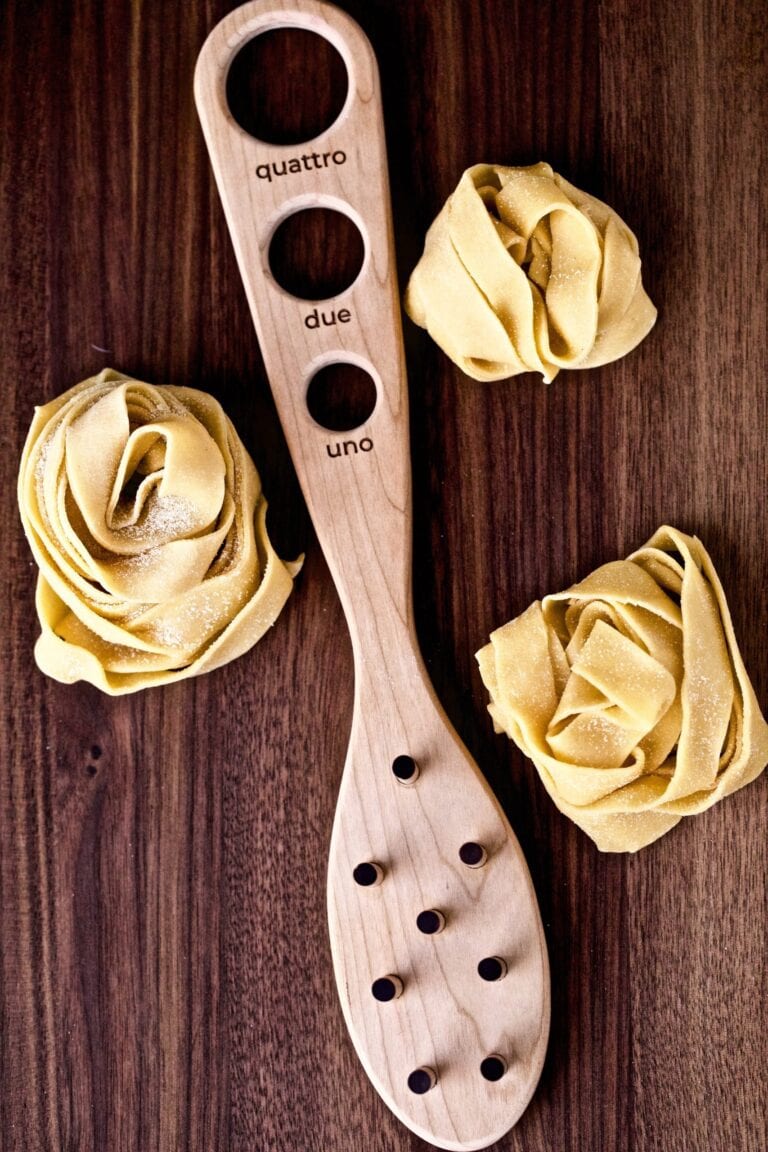Ingredients
Scale
- 4 free-range eggs (room temperature)
- 400g/14.10 oz tipo “00” or plain all-purpose flour (highly recommend weighing flour)
- Semolina flour for dusting pasta
Instructions
- Make the dough. Sift the flour on a large work surface and make a well in the center (I like to use the bottom of a bowl to make the well). Place the eggs in a bowl, then pour into the well; with a fork, break up the eggs (like you are making scrambled eggs), then gradually mix the wet ingredients into the flour mixture just until combined. Start a little at a time and create a cake batter consistency then incorporate more of the flour until a crumble consistency form. The dough may look dry and crumbly at this point. (See Notes for more)
- If you have a dough scraper you can use it to help you incorporate the ingredients.
- Knead by hand. Dust a wooden board or work surface with flour. Start kneading each piece, push the dough away from you with the heel of your hand, fold the dough over itself and turn it counterclockwise.
- Continue pushing, folding, and turning until the dough is smooth and elastic about 10 minutes. You can also knead it in a stand mixer.
- Let dough Rest. Pat the dough into a round ball. Flatten the top slightly with your hand, wrap it in plastic wrap and refrigerate for at least 30 minutes or overnight. You will know your dough is ready when it springs back after you push into the dough. I call this the “spring back test”.
- Roll out the dough. Sprinkle a large cutting board or clean the work surface with semolina. Cut 1/4 of the rested dough ball and keep the other part covered with plastic wrap so it doesn’t dry.
- Rolling Pin Method: Starting in the middle, push away from you with a rolling pin, easing up on the pressure as you approach the edge.
- Dust both sides of the dough with a little semolina so it doesn’t stick to the rolling pin and cutting board. Continue rolling the dough into a sheet, turning occasionally, until you can see your fingers through the bottom of the dough if you hold it to the light.
- Let the flat and rolled-out dough dry for about 10 minutes before cutting. You will repeat this step with all the pasta dough pieces.
- Pasta Maker Method: If you have a pasta maker you can run it through the machine. Start with setting #1. Feed through the machine once then fold each side into the middle to form a rectangle. Put it through the machine again on setting #1.
- Dust both sides of the dough with a little semolina so it doesn’t stick in the pasta machine, and repeat as needed. Now, repeat feeding through the machine and changing the setting each time from #2, #3, #4, #5, #6, until you reach setting #7- OR- until you can see your fingers through the bottom of the dough if you hold it to the light.
- Let the flat and rolled-out dough dry for about 10 minutes before cutting. You will repeat this step with all the pasta dough pieces. (see photos in post for visual aid)
- Cut the pappardelle. Dust the top of the sheet of dough with semolina flour and loosely roll it into a cylinder. Using a sharp knife, cut into 3/4-inch-wide slices.
- Unwrap the pasta; dust with semolina and gently toss to separate. Place on a sheet pan and cover with a tea towel until ready to cook (or freeze in freezer bags for up to 2 months). You can make them into little nests to store them or simply put them into a freezer-safe bag.
- Cook the pappardelle. Cook fresh pasta noodles in a large pot of boiling salted water. (Use about 6 quarts of water for 1 pound of pasta.) Fresh pasta takes considerably less time to cook than dried, usually 1 to 3 minutes, so watch it carefully. To test, remove a noodle with tongs or a pasta server spoon and take a bite.
- Serve with your favorite sauce- I list my favorites in the recipe post. Mangia! (Eat!)
Notes
Stages of Pasta Dough:
- Raw egg and flour. When you break your egg in the flour well.
- Scrambled egg in the flour well. This is when you scramble your egg in the flour well as if you are making scrambled eggs. You will not have much flour at this point.
- Cake batter stage. Mix the scrambled egg with SOME (not all) of the flour and beat until you create a cake batter-like thickness. Then slowly incorporate more flour for the next stage.
- Crumble of egg and flour. This is where you start to add more and more flour a bit at a time into the scrambled egg mixture.
- Unified dough ball. This is when the egg and flour are well incorporated and form a cohesive ball.
- Prep Time: 30 min + chill time
- Cook Time: 5 minutes
- Category: Savory
- Method: Italian
- Cuisine: Italian
